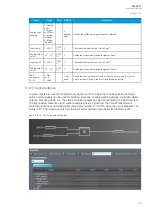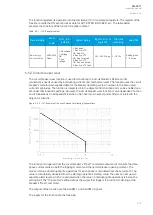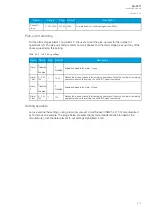
The function registers its operation into the last twelve (12) time-stamped registers. The register of the
function records the ON event process data for ACTIVATED, BLOCKED, etc. The table below
presents the structure of the function's register content.
Table. 5.5.1 - 123. Register content.
Date and time
Event
code
Volt 1, 2, 3,
4 status
System status
Input A, B, C, D
angle diff
Trip time
remaining
Used SG
dd.mm.yyyy
hh:mm:ss.mss
3392-3403
Descr.
0: No voltage
1: Voltage
OK
2: Low
voltage
0: Bus dead
1: Bus live, VTS
OK, Seq. OK
2: Bus live, VTS
OK, Seq. reversed
3: Bus live, VTS
OK, Seq. undefined
4: Bus live, VTS fault
0.00...360.00deg
0...1800s
Setting group
1...8 active
5.5.2 Circuit breaker wear
The circuit breaker wear function is used for monitoring the circuit breaker's lifetime and its
maintenance needs caused by interrupting currents and mechanical wear. The function uses the circuit
breaker's manufacturer-supplied data for the breaker operating cycles in relation to the interrupted
current magnitudes. The function is integrated into the object control function and can be enabled and
set under that function's settings. However, the circuit breaker wear function is an independent function
and it initializes as an independent instance which has its own events and settings not related to the
object it is linked to.
Figure. 5.5.2 - 141. Example of the circuit breaker interrupting life operations.
The function is triggered from the circuit breaker's "Open" command output and it monitors the three-
phase current values in both the tripping moment and the normal breaker opening moment. The
maximum value of interrupting life operations for each phase is calculated from these currents. The
value is cumulatively deducted from the starting operations starting value. The user can set up two
separate alarm levels, which are activated when the value of interrupting life operations is below the
setting limit. The "Trip contact" setting defines the output that triggers the current monitoring at the
breaker's "Open" command.
The outputs of the function are the ALARM 1 and ALARM 2 signals.
The inputs for the function are the following:
A
AQ
Q-V211
-V211
Instruction manual
Version: 2.04
212











































